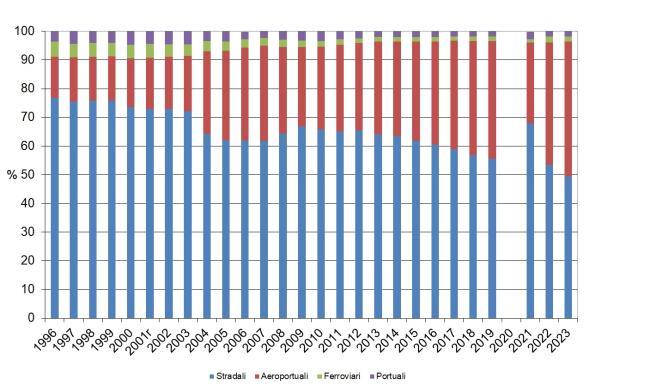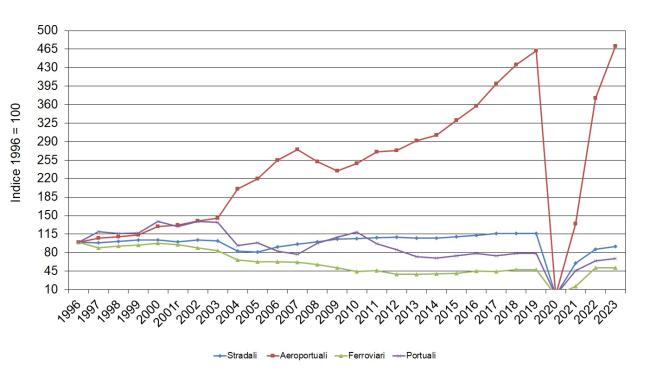Panel 1
Giovanni Finocchiaro, Silvia Iaccarino
In 2023, tourist flows at the borders continue to grow, with a total of 85.7 million foreign visitors, marking an increase of 14.7% compared to 2022. Transit across road borders is confirmed as the most used mode (49.4%), followed by airport transit (47.0%). Italians continue to prefer the car as the main means of transport for their journeys (69.5%), with a slight decrease compared to the previous year. However, train use remains marginal (11.2%), indicating a limited transition to more sustainable means of transport.
The indicator represents the distribution of tourist flows according to the means of transport used to make a journey. In the construction of the indicator, the number of foreign travelers crossing both geographical borders, such as road and rail crossings, and "virtual" ones, such as international airports and ports, and the number of trips by residents in Italy by main means of transport and type of travel are taken into consideration. The data available to analyse the different forms of transport used for tourism purposes come from different survey methodologies. The number of foreign travelers is provided by the Bank of Italy, while the number of trips by residents in Italy is based on the ISTAT survey "Travel and holidays". They are defined: business trip - stay with at least one overnight stay outside one's usual environment, mainly for business reasons; holiday trip (short and long-term) - stay of one or more consecutive nights spent outside one's usual environment, carried out mainly for reasons of pleasure, leisure, rest, including in a broader sense also trips made for other personal reasons, such as: visiting relatives and/or friends, religious reasons or pilgrimage, health treatments or spa treatments.
Highlight the different forms of transport used for tourism purposes.
The indicator has no direct references with specific regulatory elements.
Panel 2
IISTAT, various years, Travels in Italy and abroad
https://www.bancaditalia.it/statistiche/tematiche/rapporti-estero/turismo-internazionale/distribuzione-microdati/tabelle-pivot/index.html
The available data do not allow to compare the tourist flows of foreigners with those of residents in Italy, mainly due to the diversity of the survey methodologies used.
Data quality assessment
Bank of Italy
ISTAT (National Institute of Statistics)
For Italian tourist flows, ISTAT data were used: http://dati.istat.it/
For foreign tourist flows at the borders used data from the Bank of Italy:
National
1996-2023
Indicator assessment
Percentage calculation and indexing.
The high dependence on the car for tourist travel, both for Italians (69.5%) and for foreigners (49.4%), continues to represent an environmental criticality. CO₂ emissions from road transport contribute significantly to air pollution and climate change, exacerbating the environmental impact of tourism. The modest use of means of transport with a lower environmental impact, such as the train (11.2% for Italians), highlights the need for more incisive policies to promote sustainable tourist mobility.
The trend shows an increase in overall tourist flows compared to previous years, with a significant post-pandemic recovery. However, road transport continues to be dominant, limiting progress towards sustainability. From 2019 to 2023, the percentage breakdown of foreign tourist transits shows a slight decrease in the weight of road borders (from 55.5% to 49.4%) and an increase in airport borders (from 41.1% to 47.0%), while rail borders remain marginal, stable at around 1.6-1.9%. These changes do not indicate absolute increases for environmentally friendly modes, but rather confirm the persistent centrality of emission-intensive vehicles.
The use of the train by Italians remains limited, denoting a delay in the spread of eco-friendly tourist mobility practices.
Data
Table 1: Foreign visitors entering Italy through border crossings
ISPRA elaboration on data from the Bank of Italy
r The 2001 data relating to road and air border crossings have been revised following an improvement in the survey methodology
Table 2: Trips by Italians broken down into overall and only in Italy, by main means of transport used and type of trip
ISPRA elaboration on ISTAT data - Multipurpose survey "Travel and holidays" (until 2013) and ISTAT survey Travel and holiday managers (since 2014)
a A car means: your own car, that of relatives or friends or rented; b Ship means: ship, boat, motorboat; c Other means: tourist or scheduled buses, campers, motorhomes, other means of transport not elsewhere specified including motorcycles, scooters, bicycles, etc.; d The estimate has a relative error between 25% and 30%; e The estimate has a relative error of more than 30%; .. The estimate does not reach half of the minimum order of magnitude allowed



In 2023, car transport remains the most used by Italians for their journeys (58.8%), while the train, although growing, still accounts for only 11.2% of preferences. International tourist flows see a clear recovery, with an increase of 14.7% compared to 2022. However, the increase in road and air traffic negatively affects greenhouse gas emissions, making it urgent to adopt measures that encourage the use of transport with a lower environmental impact. Sustainable tourism, included among the goals of the 2030 Agenda, requires targeted interventions to improve the accessibility of rail transport and promote cycle tourism and soft mobility. Infrastructure and incentive policies should focus on reducing dependence on private cars, favouring collective and environmentally friendly modes of transport to reduce the environmental footprint of the tourism sector.